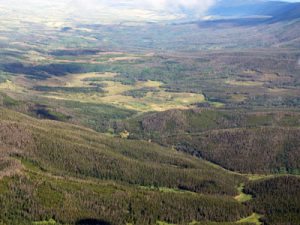
FORT COLLINS, Colo. – Spruce beetle was the most damaging forest insect pest in Colorado for the fifth consecutive year, based on a 2016 forest health aerial survey conducted by the Colorado State Forest Service (CSFS) and U.S. Forest Service (USFS), Rocky Mountain Region. Douglas-fir beetle populations also continued to expand, while mountain pine beetle, western spruce budworm and Douglas-fir tussock moth populations continue to decline.
Spruce beetle populations continued to cause widespread tree mortality, impacting 350,000 acres of higher-elevation stands of Engelmann spruce statewide. The largest infestations were detected primarily in southern and central Colorado. Blowdown events in Engelmann spruce stands, combined with long-term drought stress, warmer temperatures and extensive amounts of older, densely growing trees, have contributed to this ongoing epidemic.
Since 1996, spruce beetle outbreaks have caused tree mortality on more than 1.7 million acres in Colorado.
Beetle-kill can help fuel large wildland fires
The aerial survey also indicated that activity of Douglas-fir beetle significantly increased on the Western Slope, with 19,000 acres impacted in 2016. Unlike spruce beetle, populations of this pest tend to erupt in numerous smaller pockets, rather than spreading outwardly from a few main population centers. Eagle, Garfield and Pitkin counties, along with most of the Gunnison Basin, were all heavily impacted with pocket activity in 2016.
Conversely, declines in impacted acreage were observed for western spruce budworm, Douglas-fir tussock moth and fungal leaf diseases of aspen trees.
Mountain pine beetle, which impacted nearly 3.4 million cumulative acres statewide over the past two decades, also has declined for years and remains at background levels, with fewer than a thousand acres affected statewide in 2016. But the Beaver Creek Fire that burned more than 38,000 acres in Jackson County last year, much of it in areas previously impacted by mountain pine beetle, provides an example of how beetle-kill can help fuel large, intense wildland fires.
“Our partnership with the U.S. Forest Service on the aerial survey provides another great example of how working together, we can most effectively address forest health concerns that span property lines, including bark beetle outbreaks,” said Mike Lester, state forester and director of the CSFS. “Information we obtain from the survey helps stimulate real work on the ground and allows us to focus our efforts on priority areas.”
CSFS publications about spruce beetle, Douglas-fir beetle and many other pests, as well as how private landowners can manage them, are available online at www.csfs.colostate.edu/csfspublications.
For more information, view this Aerial Survey Highlights for Colorado, 2016 document (PDF).

